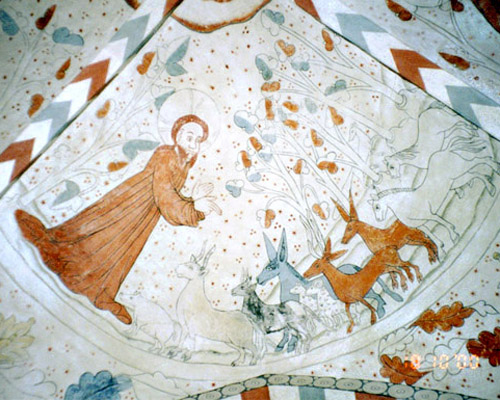| Verdensbilledet

| | I de 28 år, fra 1201-1228, hvor Anders Sunesen sidder som ærkebiskop i Lund konsoliderer han på forskellig vis kirkens indflydelse på dagligliv og verdensanskuelse.
Verdens centrum er på middelalderlige kort ofte Jerusalem og det åndelige centrum Peterskirken i Rom |
Kirkens åndelige magt
I tidsrummet fra slutningen af 900-tallet og frem til omkring år 1200 skaber en styrket kongemagt i samarbejde med kirken og stormandsslægter et middelaldersamfund, hvor kongemagten i samarbejde med rigets ledende mænd udøver den verdslige magt, mens kirken centrum i ærkebispesædet i Lund har den åndelige overhøjhed i regionen.
I de 28 år, fra 1201-1228, hvor Anders Sunesen sidder som ærkebiskop i Lund konsoliderer han på forskellig vis kirkens indflydelse på dagligliv og verdensanskuelse. Verdens centrum er på middelalderlige kort ofte Jerusalem og det åndelige centrum Peterskirken i Rom, hvilket dog ikke forhindrer ærkebispesæderne i at etablere regionale centre af betydeligt format. I Anders Sunesens tid opnår Lund således at blive et betydeligt åndeligt og intellektuelt center, -et verdenscenter, således som det fremgår af kirkens astronomiske ur, der dog er fra et senere tidspunkt.
I Lund var udbredelsen af boglig lærdom i bestræbelserne på at uddanne præstestanden og udbrede kirkens verdensbillede et vigtigt anliggende. Anders Sunesen forfatter selv det lange læredigt Hexaëmeron, som bl.a. giver et billede af periodens bibelfortolkning og det herskende verdensbillede. Anders Sunesen beskæftiger sig her bl.a. med problematikken omkring verdens skabelse og den himmelske orden.

Hexaömeron | 
Vitskøvle | 
Jerusalem i centrum |
Det fysiske Verdensbillede
Det også omkring dette tidspunkt at kirken beslutter sig for at adoptere centrale dele af den den klassiske filosof Aristoteles syn på den fysiske verdens opbygning, en såkaldt kosmologi. Aristoteles mente som udgangspunkt at den fysiske verden bestod af fire grundelementer, som var præget af en indbyrdes formålsbestemhed.
De fire grundelementer jord, vand, luft og ild befinder sig indenfor samme sfære, eller område, men vil alt efter beskaffenhed søge henholdsvis opad, eller nedad. Jorden, som er det tungeste element, vil søge nedad, eller ind mod universets centrum, jordkloden, mens vandet med mindre tyngde vil lejere sig ovenpå dette. Luften, som er endnu lettere, vil søge opad, som luftbobler gennem vand. Ilden som jo iagttageligt søger op i luften, er det letteste element.
På middelalderlige fremstillinger skildres de fire elementer som ordnede lag udenpå hinanden, men i ”virkeligheden” er de i konstant bevægelse. Denne sublunare(under månen) verden står i modsætning til det ydre univers, hvor planeterne bevæger sig i regelmæssige baner og består af et mere fuldkomment element(æther). Aristoteles opfattede ætherverdenen, som en fuldendt, himmelsk verden. Man indser at det stemmer godt overens med en kristen grundopfattelse og dette fysiske verdensbillede anfægtes også først for alvor ind i 1500-tallet.

Middelalderens verdensbillede | 
Middelalderens verdenbillede | 
Verdensaltet 1474 |
|